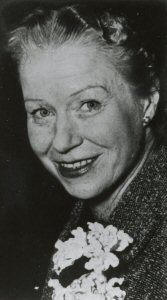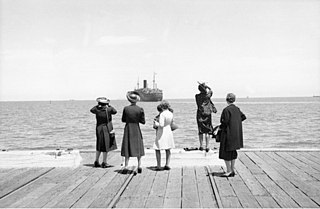 W
WAustralian women during World War II played a larger role than they had during World War I.
 W
WThe Women's Auxiliary Australian Air Force (WAAAF) was formed in March 1941, after considerable lobbying by women keen to serve and by the Chief of the Air Staff, who wanted to release male personnel serving in Australia for service overseas. The WAAAF was the first and largest of the wartime Australian women's services. It was disbanded in December 1947.
 W
WThe Australian Women's Army Service (AWAS) was a non-medical women's service established in Australia during the Second World War. Raised on 13 August 1941 to "release men from certain military duties for employment in fighting units" the service grew to over 20,000-strong and provided personnel to fill various roles including administration, driving, catering, signals and intelligence. Following the end of the Second World War, the service was demobilised and ceased to exist by 1947. It later provided a cadre of experienced personnel to the Women's Royal Australian Army Corps when it was established in 1951.
 W
WThe Australian Women's Land Army (AWLA) was an organisation created in World War II in Australia to combat rising labour shortages in the farming sector. The AWLA organised female workers to be employed by farmers to replace male workers who had joined the armed forces.
 W
WThe Women's Royal Australian Naval Service (WRANS) was the women's branch of the Royal Australian Navy (RAN). In 1941, fourteen members of the civilian Women's Emergency Signalling Corps (WESC) were recruited for wireless telegraphy work at the Royal Australian Navy Wireless/Transmitting Station Canberra, as part of a trial to free up men for service aboard ships. Although the RAN and the Australian government were initially reluctant to support the idea, the demand for seagoing personnel imposed by the Pacific War saw the WRANS formally established as a women's auxiliary service in 1942. The surge in recruitment led to the development of an internal officer corps. Over the course of World War II, over 3,000 women served in the WRANS.
 W
WFaith Bandler was an Australian civil rights activist of South Sea Islander and Scottish-Indian heritage. A campaigner for the rights of Indigenous Australians and South Sea Islanders, she was best known for her leadership in the campaign for the 1967 referendum on Aboriginal Australians.
 W
WThe Bibra Lake Australian Women's Army Service (AWAS) camp was a collection of pre-fab army huts built in the vicinity of Bibra Lake in Cockburn. The camp was probably constructed in 1943, and the women posted there were part of the 66 Anti-aircraft (AA) searchlight (SL) battery. The camp was located near Hope Road, which runs between Bibra and North Lakes. Though dismantled immediately after the war, some remains can still be seen in the area.
 W
WMary Gwenyth "Gwen" Fleming, FRACP, was an Australian medical doctor who specialised in thoracic medicine and served in the Royal Australian Army Medical Corps during the Second World War.
 W
WDr Dame Mary Ranken Herring, was an Australian medical practitioner and community worker.
 W
WSybil Howy Irving, MBE was the founder and controller of the Australian Women's Army Service during World War II. She served in this position from 1941 to 1946 and was active in charity and social organisations until she was aged 74.
 W
WAgnes Betty Jeffrey, OAM was an Australian writer who wrote about her Second World War nursing experiences in the book White Coolies.
 W
WMabel Josephine (Jo) Mackerras was an Australian zoologist, entomologist and parasitologist. Her research and life’s work contributed to entomology, veterinary medicine and medical science. Throughout her life she held a wide range of positions and duties that included Army medical officer, entomologist, medical scientist, and parasitologist. Mackerras was a major during WWII and served in the Army Malaria Research Unit. In an application for King’s Birthday Honours her work earned the citation,: "few women can have made a greater contribution to the Allied war effort".
 W
WFlorence Violet McKenzie OBE, affectionately known as "Mrs Mac", was Australia's first female electrical engineer, founder of the Women's Emergency Signalling Corps (WESC) and lifelong promoter for technical education for women. She campaigned successfully to have some of her female trainees accepted into the all-male Navy, thereby originating the Women's Royal Australian Naval Service (WRANS). Some 12,000 servicemen passed through her signal instruction school in Sydney, acquiring skill in Morse code and visual signalling.
 W
WDame Mabel Flora Miller, DBE was an Australian lawyer and politician. She was the first woman elected to the Hobart City Council and one of the first two women to be elected to the Tasmanian House of Assembly.
 W
WEvadne Price, probably born Eva Grace Price, was an Australian-British writer, actress, astrologer and media personality. She also wrote under the pseudonym Helen Zenna Smith.
 W
WAlys Ross King, known as Alice Ross-King, was an Australian civilian and military nurse who took part in both World Wars. She has been described as Australia's most decorated woman. During the First World War she served in hospitals in Egypt and France and was one of only seven Australian nurses decorated with the Military Medal for gallantry. In the Second World War she held a senior post within the Australian Army Medical Women's Service. In 1949 she was awarded the Florence Nightingale Medal, the highest award made by the International Committee of the Red Cross.
 W
WGladys Sandford was an Australian-New Zealand pioneering driver and aviator. She was the first woman in New Zealand to earn a pilot's licence.
 W
WJessie Mary Vasey was the founder and President of the War Widows' Guild of Australia.